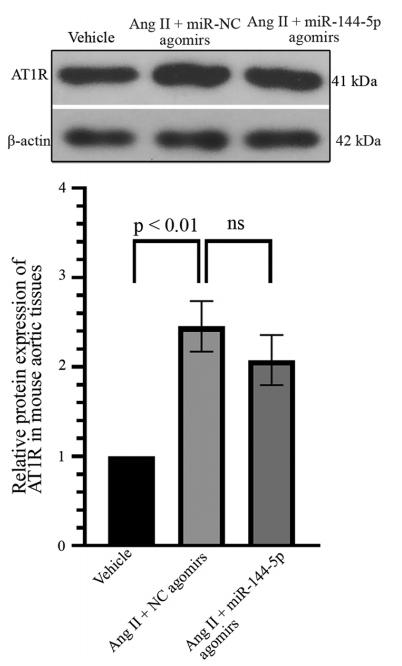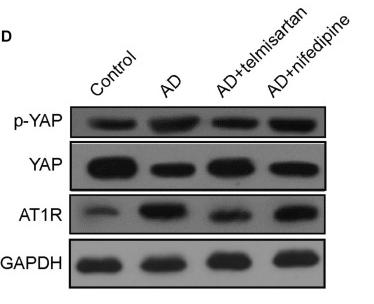AGTR1 Antibody - #DF4910
製品説明
*The optimal dilutions should be determined by the end user. For optimal experimental results, antibody reuse is not recommended.
*Tips:
WB: For western blot detection of denatured protein samples. IHC: For immunohistochemical detection of paraffin sections (IHC-p) or frozen sections (IHC-f) of tissue samples. IF/ICC: For immunofluorescence detection of cell samples. ELISA(peptide): For ELISA detection of antigenic peptide.
引用形式: Affinity Biosciences Cat# DF4910, RRID:AB_2837263.
折りたたみ/展開
AG2S; Agtr 1; Agtr1; AGTR1_HUMAN; Agtr1a; AGTR1B; Ang II; Angiotensin II receptor type 1; Angiotensin II type-1 receptor; Angiotensin receptor 1; Angiotensin receptor 1B; AT 1B; AT 1r; AT1; At1a; AT1AR; AT1B; AT1BR; AT1R; AT2R1; AT2R1A; AT2R1B; HAT1R; Type 1 angiotensin II receptor; Type 1B angiotensin II receptor; Type-1 angiotensin II receptor;
免疫原
A synthesized peptide derived from human AGTR1, corresponding to a region within N-terminal amino acids.
- P30556 AGTR1_HUMAN:
- Protein BLAST With
- NCBI/
- ExPASy/
- Uniprot
MILNSSTEDGIKRIQDDCPKAGRHNYIFVMIPTLYSIIFVVGIFGNSLVVIVIYFYMKLKTVASVFLLNLALADLCFLLTLPLWAVYTAMEYRWPFGNYLCKIASASVSFNLYASVFLLTCLSIDRYLAIVHPMKSRLRRTMLVAKVTCIIIWLLAGLASLPAIIHRNVFFIENTNITVCAFHYESQNSTLPIGLGLTKNILGFLFPFLIILTSYTLIWKALKKAYEIQKNKPRNDDIFKIIMAIVLFFFFSWIPHQIFTFLDVLIQLGIIRDCRIADIVDTAMPITICIAYFNNCLNPLFYGFLGKKFKRYFLQLLKYIPPKAKSHSNLSTKMSTLSYRPSDNVSSSTKKPAPCFEVE
種類予測
Score>80(red) has high confidence and is suggested to be used for WB detection. *The prediction model is mainly based on the alignment of immunogen sequences, the results are for reference only, not as the basis of quality assurance.
High(score>80) Medium(80>score>50) Low(score<50) No confidence
研究背景
Receptor for angiotensin II. Mediates its action by association with G proteins that activate a phosphatidylinositol-calcium second messenger system.
C-terminal Ser or Thr residues may be phosphorylated.
Cell membrane>Multi-pass membrane protein.
Liver, lung, adrenal and adrenocortical adenomas.
Belongs to the G-protein coupled receptor 1 family.
研究領域
· Environmental Information Processing > Signal transduction > Calcium signaling pathway. (View pathway)
· Environmental Information Processing > Signal transduction > cGMP-PKG signaling pathway. (View pathway)
· Environmental Information Processing > Signal transduction > Phospholipase D signaling pathway. (View pathway)
· Environmental Information Processing > Signaling molecules and interaction > Neuroactive ligand-receptor interaction.
· Environmental Information Processing > Signal transduction > Apelin signaling pathway. (View pathway)
· Human Diseases > Cancers: Overview > Pathways in cancer. (View pathway)
· Organismal Systems > Circulatory system > Adrenergic signaling in cardiomyocytes. (View pathway)
· Organismal Systems > Circulatory system > Vascular smooth muscle contraction. (View pathway)
· Organismal Systems > Endocrine system > Renin-angiotensin system. (View pathway)
· Organismal Systems > Endocrine system > Renin secretion.
· Organismal Systems > Endocrine system > Aldosterone synthesis and secretion.
参考文献
Application: WB Species: rat Sample: renal cortical
Application: WB Species: mouse Sample:
Application: WB Species: Mice Sample: aortic tissue
Application: WB Species: Rat Sample:
Application: WB Species: human Sample: HAECs
Restrictive clause
Affinity Biosciences tests all products strictly. Citations are provided as a resource for additional applications that have not been validated by Affinity Biosciences. Please choose the appropriate format for each application and consult Materials and Methods sections for additional details about the use of any product in these publications.
For Research Use Only.
Not for use in diagnostic or therapeutic procedures. Not for resale. Not for distribution without written consent. Affinity Biosciences will not be held responsible for patent infringement or other violations that may occur with the use of our products. Affinity Biosciences, Affinity Biosciences Logo and all other trademarks are the property of Affinity Biosciences LTD.







